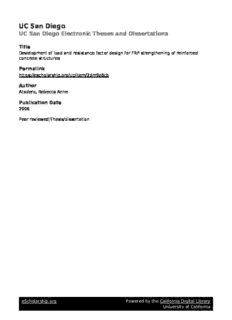Table Of ContentUC San Diego
UC San Diego Electronic Theses and Dissertations
Title
Development of load and resistance factor design for FRP strengthening of reinforced
concrete structures
Permalink
https://escholarship.org/uc/item/2dm9z8cb
Author
Atadero, Rebecca Anne
Publication Date
2006
Peer reviewed|Thesis/dissertation
eScholarship.org Powered by the California Digital Library
University of California
UNIVERSITY OF CALIFORNIA, SAN DIEGO
Development of Load and Resistance Factor Design for
FRP Strengthening of Reinforced Concrete Structures
A dissertation submitted in partial satisfaction of the
requirements for the degree Doctor of Philosophy
in
Structural Engineering
by
Rebecca Anne Atadero
Committee in Charge:
Professor Vistasp M. Karbhari, Chair
Professor Gilbert A. Hegemier
Professor Francesco Lanza di Scalea
Professor Marc A. Meyers
Professor Jeffrey M. Rabin
2006
Copyright
Rebecca Anne Atadero, 2006
All rights reserved.
The dissertation of Rebecca Anne Atadero is approved,
and it is acceptable in quality and form for publication
on microfilm:
__________________________________________________
__________________________________________________
__________________________________________________
__________________________________________________
__________________________________________________
Chair
University of California, San Diego
2006
iii
DEDICATION
To my husband, Todd, maybe I could have done it without you, but I am sure glad that I didn’t
have to. You are my sunshine and I love you!
iv
TABLE OF CONTENTS
Signature Page...........................................................................................................................iii
Dedication.................................................................................................................................iv
Table of Contents.......................................................................................................................v
List of Figures.......................................................................................................................xviii
List of Tables...........................................................................................................................xxi
Acknowledgements...............................................................................................................xxvi
Vita.......................................................................................................................................xxvii
Abstract...............................................................................................................................xxviii
Chapter 1. Introduction..............................................................................................................1
1.1 Overview................................................................................................................1
1.2 FRPs for Strengthening of Civil Structures............................................................1
1.2.1 Fiber Reinforced Polymer Composites............................................................1
1.2.2 Strengthening and Repair of Civil Structures...................................................2
1.2.3 Advantages of FRPs for Strengthening............................................................4
1.2.4 Disadvantages of FRPs for Strengthening.......................................................5
1.3 Design Code for FRP Strengthening......................................................................5
1.3.1 Need for a Design Code...................................................................................5
1.3.2 Uncertainty in Structural Design......................................................................7
1.3.3 Design Philosophies as the Basis for Design Codes........................................7
1.3.3.1 Working Stress Design............................................................................8
1.3.3.2 Load and Resistance Factor Design........................................................8
1.3.3.3 Advantages of LRFD.............................................................................10
1.3.4 Current Design Guidelines for FRP Strengthening........................................11
v
1.4 Problem Statement and Research Objectives.......................................................13
1.4.1 Problem Description.......................................................................................13
1.4.2 Research Objectives.......................................................................................15
1.4.3 Research Approach........................................................................................16
1.4.4 Outline of the Dissertation.............................................................................19
Chapter 2. Background for Structural Reliability, LRFD and Design Uncertainty..................22
2.1 Introduction...........................................................................................................22
2.2 Structural Reliability Methods..............................................................................22
2.2.1 Uncertainty and Risk......................................................................................22
2.2.2 Evaluation of Structural Reliability................................................................24
2.2.2.1 Effect of Uncertainty.............................................................................24
2.2.2.2 Deterministic Safety Factors.................................................................25
2.2.2.3 Basic Reliability Problem......................................................................26
2.2.2.4 The Reliability Index.............................................................................29
2.2.2.5 Methods of Computing the Reliability Index........................................32
2.2.2.5.1 First-Order, Second-Moment Reliability Index...........................32
2.2.2.5.2 First- and Second-Order Reliability Methods (FORM and
SORM)….......................................................................................................33
2.2.2.5.3 Monte Carlo Simulation (MCS)...................................................34
2.2.2.5.4 Other Techniques.........................................................................35
2.2.2.6 Levels of Reliability Methods...............................................................35
2.2.2.7 Component vs. System Reliability........................................................36
2.2.2.8 Time-dependent Reliability...................................................................37
2.2.2.9 Limitations of Reliability Methods.......................................................38
vi
2.2.2.10 Reliability Methods Used for This Dissertation..................................39
2.3 Previous Development of LRFD..........................................................................41
2.3.1 Steel................................................................................................................41
2.3.2 Loads..............................................................................................................42
2.3.3 Engineered Wood...........................................................................................43
2.3.4 Bridges...........................................................................................................43
2.3.5 Concrete.........................................................................................................45
2.3.6 Aspects of Existing Codes Considered in this Work.....................................45
2.4 Previous Work on Reliability of FRP in Civil Infrastructure...............................46
2.4.1 FRP for Strengthening....................................................................................46
2.4.1.1 Limitations of Existing Studies.............................................................49
2.4.2 FRP for New Construction.............................................................................50
2.4.2.1 General Design Standards.....................................................................51
2.5 Statistical Descriptors for Resistance Variables...................................................52
2.5.1 Concrete.........................................................................................................53
2.5.2 Reinforcing Steel............................................................................................55
2.5.3 Dimensions.....................................................................................................56
2.5.3.1 Area of Steel..........................................................................................57
2.5.3.2 Slab Dimensions....................................................................................57
2.5.3.3 Beam Dimensions..................................................................................57
2.5.4 Modeling Uncertainty....................................................................................58
2.6 Description of Load Variables..............................................................................60
2.6.1 Dead Load......................................................................................................61
2.6.2 Live and Impact Loads...................................................................................61
vii
2.7 Consideration of Continued Degradation.............................................................68
2.7.1 Modes of Reinforced Concrete Degradation..................................................68
2.7.2 Corrosion of Steel in Concrete.......................................................................69
2.7.2.1 Carbonation-Induced Corrosion............................................................71
2.7.2.2 Chloride-Induced Corrosion..................................................................72
2.7.2.3 Rates of Corrosion.................................................................................72
2.7.3 Previous Work Modeling Corrosion-Induced Degradation in Bridges..........74
2.7.4 Corrosion Models Used in this Dissertation...................................................76
2.7.4.1 Major Assumptions for Corrosion Modeling........................................76
2.7.4.2 Mathematical Models for Corrosion.....................................................78
2.8 Target Reliability Index........................................................................................81
2.8.1 Comparison to Other Acceptable Levels of Risk...........................................82
2.8.2 Optimization of Cost-Benefit.........................................................................83
2.8.3 Empirical Approaches....................................................................................83
2.8.4 Calibration to Safety Levels Implied by Existing Codes...............................86
2.8.4.1 Reliability Indices from Other LRFD Codes.........................................87
2.8.5 Selection of Target β for this Work................................................................90
2.9 Discussion of Background Data...........................................................................92
Chapter 3. Characterization of Composite Properties for Reliability Analysis and Design.....94
3.1 Introduction...........................................................................................................94
3.2 Description of Data Sets.......................................................................................95
3.2.1 Testing Procedures.........................................................................................95
3.2.2 Wet Layup Composites..................................................................................95
3.3 Characterization of Random Variation.................................................................98
viii
3.3.1 A Note on the Effect of Thickness.................................................................98
3.3.2 Basic Statistics...............................................................................................99
3.3.3 Statistical Distributions for Representing Composite Properties.................104
3.3.3.1 Distributions........................................................................................104
3.3.3.2 Distributions Fit to Wet Layup Composite Data.................................107
3.3.4 Best Fitting Distributions.............................................................................111
3.3.4.1 Strength...............................................................................................112
3.3.4.2 Modulus...............................................................................................114
3.3.4.3 Thickness.............................................................................................116
3.3.4.4 Summary of Distributions for Reliability Analysis.............................118
3.3.5 Correlation between Variables.....................................................................119
3.4 Design Values for Composite Materials.............................................................121
3.4.1 Current Approaches to Selection of Design Values.....................................121
3.4.1.1 Reliability Implications of Current Design Approach.........................123
3.4.2 Proposed Approach to Design Values..........................................................128
3.4.2.1 Accounting for Material Variability....................................................128
3.4.2.2 Use of the Mean as the Characteristic Value.......................................130
3.4.2.3 Factors for Systematic Variation and Time-Dependent Behavior.......131
3.4.2.4 Promoting Reliability-Based Design...................................................131
3.5 Characterizing and Accounting for Systematic Differences between Laboratory
Derived Design Values and In-Situ Properties................................................................133
3.5.1 Currently Used Factors................................................................................133
3.5.2 Types of Systematic Variation.....................................................................136
3.5.3 Proposed Set of Application Factors............................................................137
ix
Description:In 7th International Symposium on Fiber-Reinforced Polymer (FRP). Reinforcement for Concrete .. codes of practice, and, without a comprehensive specification for FRP, it is unlikely that this promising new adopted in 1986 by AISC with the first LRFD edition of the AISC Manual of Steel. Constructio

